Lupini Beans and Olives (How to Cook & Eat Lupini)
Lupini beans are not very well known in the US, but they really should be. I predict they’ll soon be one of the hot new “health foods” here; it’s only a matter of time. Not only are they a deliciously addictive snack or appetizer, but are incredibly nutritious and high in protein.
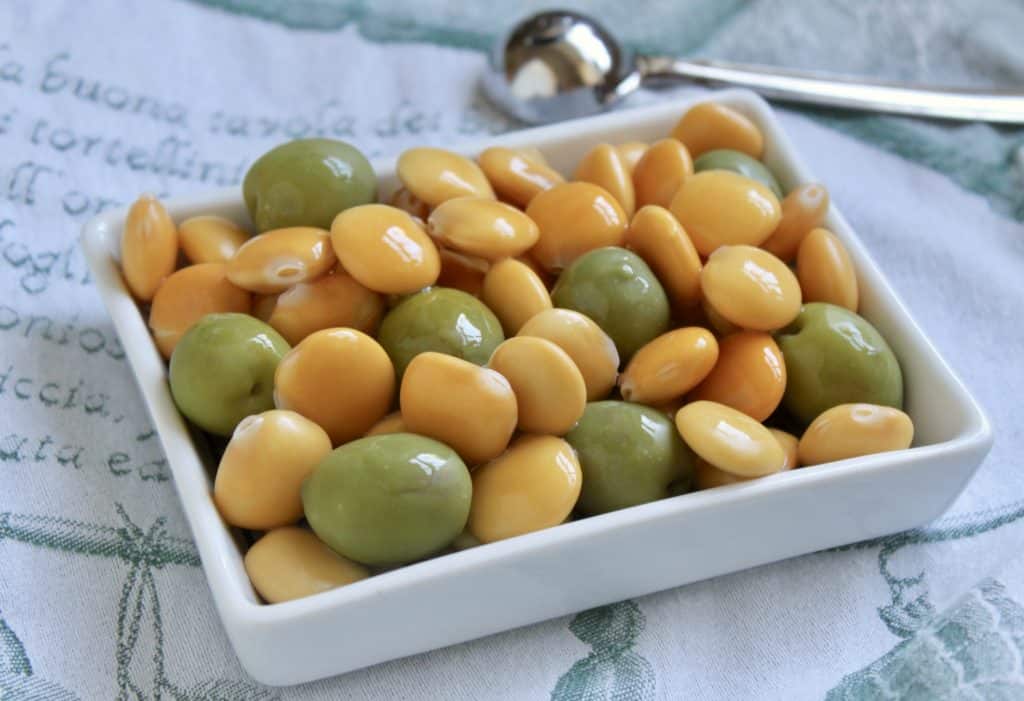
Originally published December 8, 2012.
In this article, I’m going to show you how to cook and eat lupini beans, assuming that most of you reading this have never seen or maybe even heard of lupini beans*.
As an Amazon Associate I earn from qualifying purchases.
What Are Lupini Beans?

Lupini are a very unique type of bean which are popular in Italy, especially at Christmastime.

Lupini beans are also common in Spain where they are known as altramuces, and Portugal as tremoços. They do not have the taste or texture of any other bean I’ve ever had, and they also eaten differently (see below). Lupini beans are extremely bitter before being prepared, and must be soaked overnight, cooked the next day, then rinsed several times a day for the next 5 or 6 days.
Lupini are not the same as other beans which can be cooked and ready to eat right away.
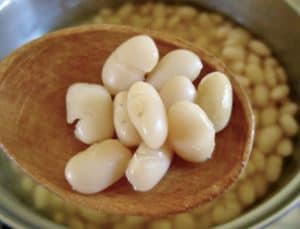
I’ve always wondered who the person was who discovered that if you just keep rinsing these beans that they would actually taste delicious, let alone edible! I can tell you, it’s no one that would get any sort of patent as lupini were eaten by ancient Egyptians! Please don’t let the process dissuade you as the end result is well worth it!
Interesting Fact: Have you ever seen lupin flowers? They are related to lupini beans.

You can just eat lupini beans as a healthy snack, antipasto or also after a meal, as they do in Italy.
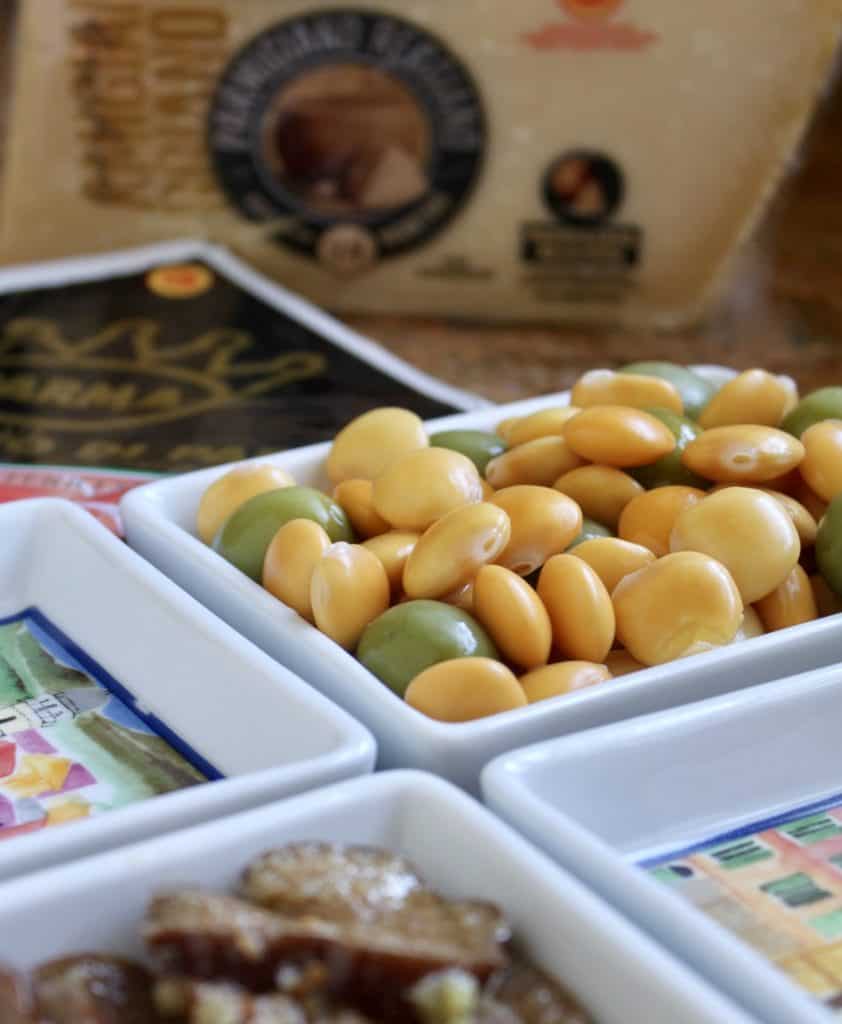
With an Italian style preparation, olives are mixed with the lupini at the end of the process, which lend their salty flavor to the beans. It’s a fabulous combination. You can find lupini beans at most Italian markets/delis and middle eastern shops. If you want a large bag of them, on (I would absolutely buy the 3 lb bag on Amazon and make them three different times).
I repeat: don’t let the process of making these intimidate you because there’s really nothing to it. The only caveat is remembering to start about six days before you want to eat them.
If you can boil beans and rinse them, you can prepare lupini.
Of course, these are great to eat as a snack because they’re so healthy and nutritious. Don’t just limit them to the Christmas season, you can eat them year-round. I will warn you though, once you start eating lupini, it’s very difficult to stop; they are very addictive.
*WARNING: Peanut allergy sufferers, please make sure you are not also allergic to lupini beans.
How to Cook Lupini Beans
Ingredients
- one bag of dry lupini beans, look for beans without blemishes (I used one 14 oz bag)
- salt
- olives, green (like these, with pits are traditionally used in Italy) or black, with the liquid
Rinse and sort (take out any bad looking beans) the lupini, then soak them overnight, a minimum of 12 hours. Make sure to put a few inches of water above the beans so they don’t dry out when you’re trying to rehydrate them.

Cook the beans
Rinse the beans, then put them into a large pot with fresh water, covering the beans with at least a couple inches of water above them.
Bring to a boil, then reduce heat and simmer for 45-50 minutes, occasionally stirring with a wooden spoon.
Remove from heat, drain, and place into a large bowl and fill to cover with water.
Rinse the beans for about 5 days
At this point, just keep rinsing the lupini for about 30 seconds at a time, 3 to 4 times a day, for about 5 days (fewer, if you change the water more often.)
The bowl can be kept on the counter; it does not need to be refrigerated.
I kept track of how many times I changed the water over 5 days, and the total count was 18. Yes, this is necessary or you will have bitter beans. Note: do not eat bitter beans, they must lose all their bitter flavor before ingesting them.
At the end of the fifth day, taste a bean, or part of one, to check for bitterness. The bean will not taste good/sweet yet, but you are only checking for bitterness, nothing else. If the lupini beans are still bitter, continue to change the water until they are no longer bitter.
Add salt and olives
Next in the process is to add some salt (about one teaspoon of Kosher salt) to the lupini in the water (do not drain the beans after this). You can also add a can of black or green olives, liquid and all (not under oil). Stir well and taste after about three hours. If it needs more salt, add some. If you make the lupini too salty, just add a little more water.
DO NOT CHANGE THE WATER AFTER THIS and refrigerate, once the salt has been added.
Now the lupini are ready to eat! Use a mini sieve or slotted spoon to put some lupini and olives into a serving bowl, keeping the main bowl in the fridge. The lupini must be kept in water in the fridge, but are best served at room temperature.
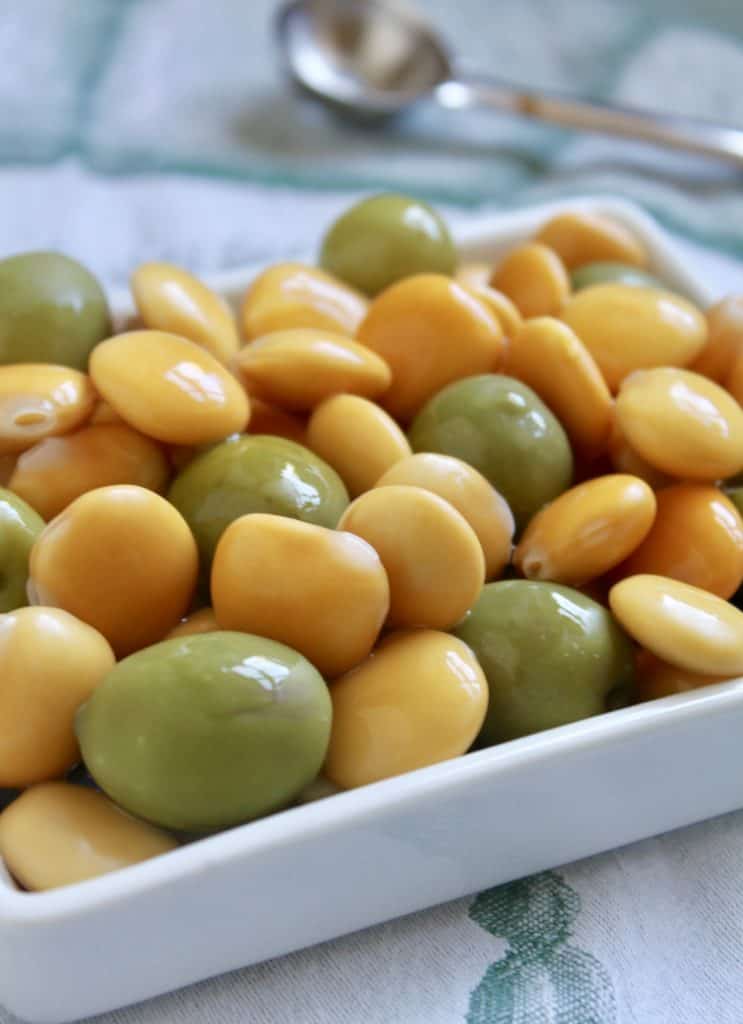
How to Eat Lupini Beans
There are three steps. Once you get the hang of it, you’ll be able to put away a dozen in under 15 seconds (don’t ask me how I know this). 🤔
- Take a lupini bean in your fingers and bite part way through the top part of the bean (where the little white part is) to break open the skin, but don’t bite the bean inside.
- Now, just squeeze gently while holding the bean in front of your mouth, and POP the bean in! I told you lupini were cooked and eaten differently than any other bean. 😁
- Discard the skin.
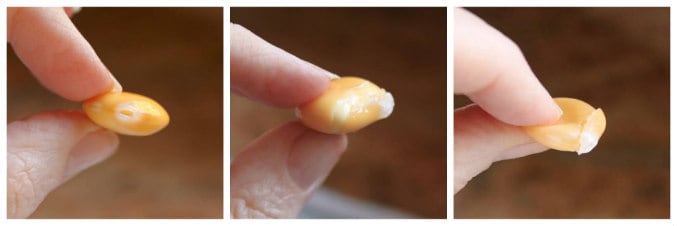
Can You Eat the Skin of a Lupini Bean?
Yes, the skin is edible. I can tell you that my brother and son just pop the whole bean into their mouths. However, I don’t like the texture of the skins, so I don’t eat them.
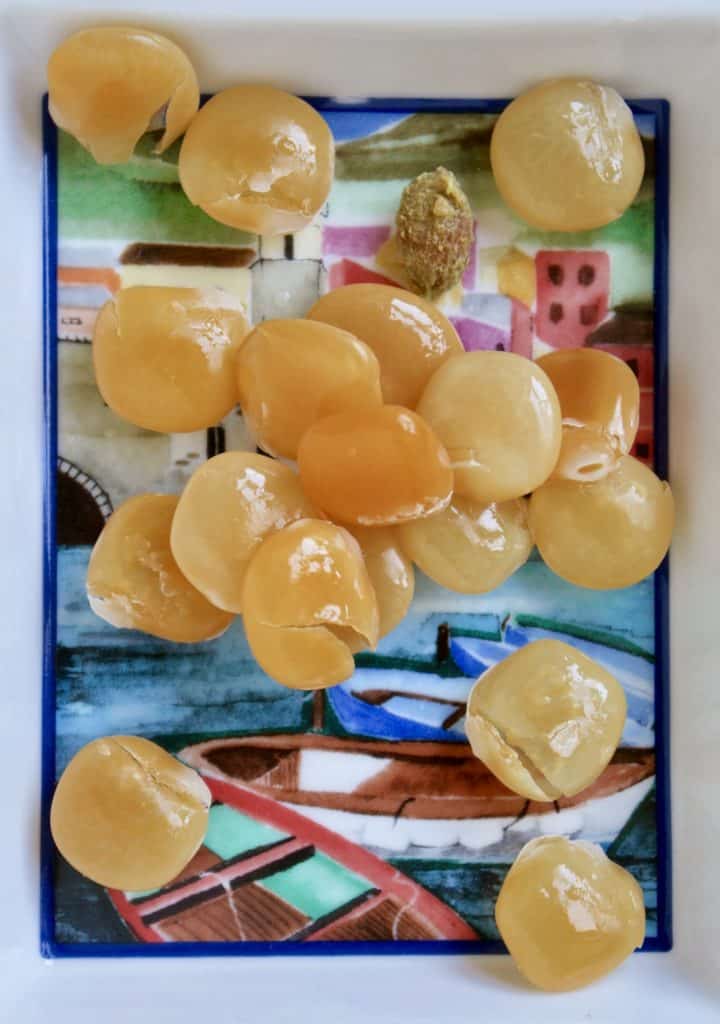
Once you get started, you won’t be able to stop, but remember, they are beans, so you probably don’t want to eat too many in one sitting. Now you know how to cook and eat lupini beans. Enjoy!
Interested in other traditional Italian dishes for Christmas Eve and Christmas Day? Just click the following photo or this link.
CLICK HERE to check out my Gift Guide and Product Recommendation List on Amazon!
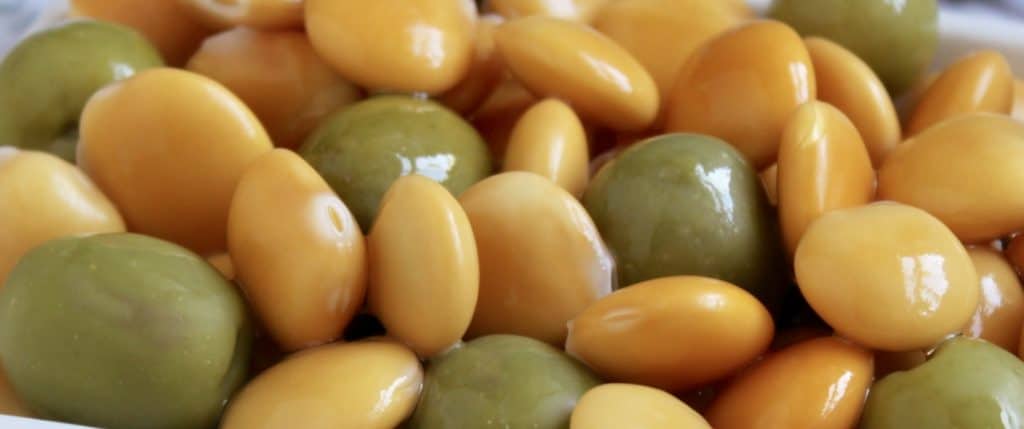
Don’t miss another post! Sign up for my free subscription for recipes and travel.
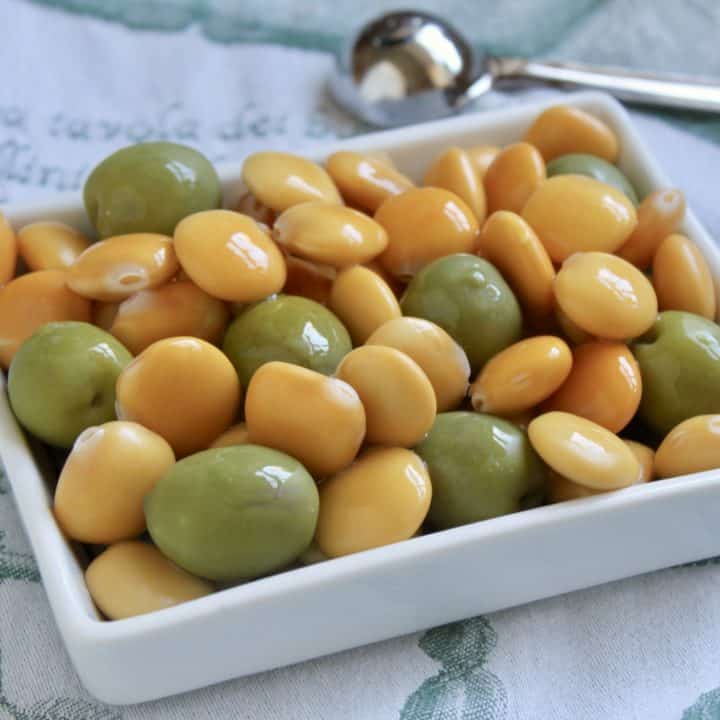
Lupini Beans and Olives, An Italian Christmas Tradition (How to Cook & Eat Lupini)
A super nutritious, healthy and addictive traditional Italian snack. Lupini beans and olives are usually served at Christmastime in Italy.
Ingredients
- one bag of dry lupini beans, look for beans without blemishes (I used one 14 oz bag)
- salt
- olives, green (like Castelvetrano, with pits are traditionally used in Italy) or black olives, with the liquid
Instructions
- Rinse and sort (take out any bad looking beans) the lupini, then soak them overnight, a minimum of 12 hours. Make sure to put a few inches of water above the beans so they don't dry out when you're trying to rehydrate them.
- Rinse the beans, then put them into a large pot with fresh water, covering the beans with at least a couple inches of water above them.
- Bring to a boil, then reduce heat and simmer for 45-50 minutes, occasionally stirring with a wooden spoon.
- Remove from heat, drain, and place into a large bowl and fill to cover with water.
- At this point, just keep rinsing the lupini for about 30 seconds at a time, 3 to 4 times a day, for about 5 days (fewer, if you change the water more often.)
- The bowl can be kept on the counter; it does not need to be refrigerated.
- I kept track of how many times I changed the water over 5 days, and the total count was 18. Yes, this is necessary or you will have bitter beans.
- At the end of the fifth day, taste a bean, or part of one, to check for bitterness. The bean will not taste good/sweet yet, but you are only checking for bitterness, nothing else. If the lupini beans are still bitter, continue to change the water until they are no longer bitter.
- Next in the process is to add some salt, probably about one teaspoon of Kosher salt to the lupini in the water (do not drain the beans after this.) You can also add a can of green (this is the Italian style) or black olives, liquid and all (not under oil). Stir well and taste after about three hours. If it needs more salt, add some. If you make the lupini too salty, just add a little more water.
- DO NOT CHANGE THE WATER ANYMORE and refrigerate, once the salt has been added.
- Now the lupini are ready to eat! Use a mini sieve or slotted spoon to put some lupini and olives into a serving bowl.
Notes
Nutrition info is just for the lupini.
Nutrition Information:
Yield: 18 Serving Size: 1Amount Per Serving: Calories: 25Total Fat: 0gSaturated Fat: 0gTrans Fat: 0gUnsaturated Fat: 0gCholesterol: 0mgSodium: 84mgCarbohydrates: 4gFiber: 1gSugar: 1gProtein: 2g
Nutrition information is only estimated.
Christina’s Cucina is a participant in the Amazon Services LLC Associates Program, an affiliate advertising program designed to provide a means for sites to earn advertising fees by advertising and linking to Amazon.com.




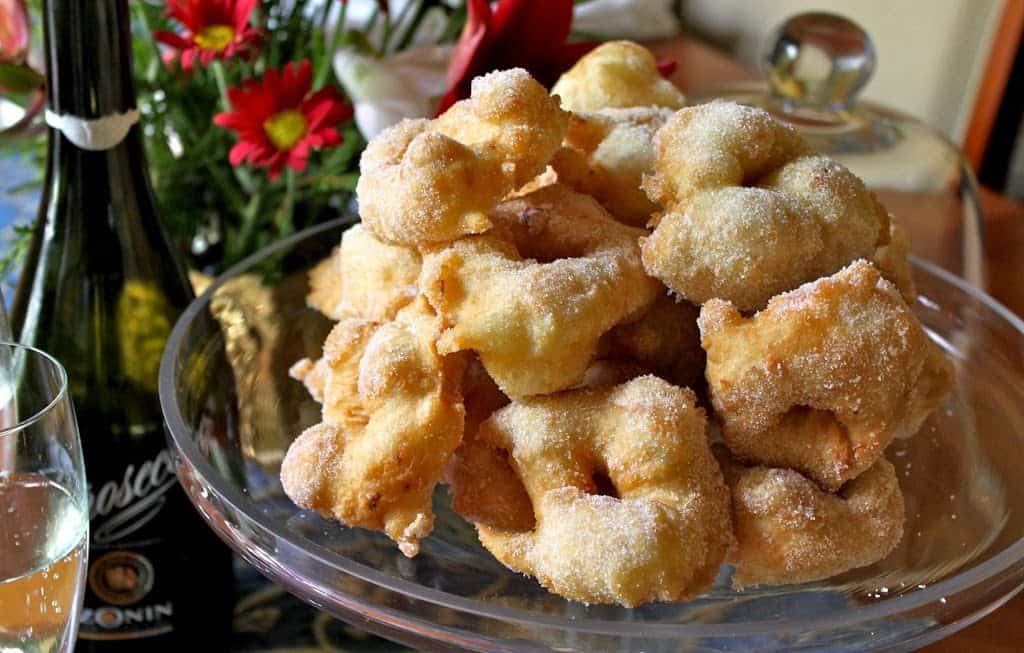
An easy way to make the soaking easier is to put the cooked Lupini in a cheesecloth sack, and hang them in the toilet tank. Then every time someone flushes the toilet, the Lupini are rinsed! My Italian cousins said their grandparents used this technique.
Wow, George! Never heard of this technique. Personally, I wouldn’t want my lupini in the toilet! ;)
I remember growing upon my grandparent’s farm. My grandma would put the lupini in a burlap sack and place it a nearby creek to cure in about 3days
Wow, now that’s really cool! I’d love to try that someday. Thanks for the note, Jerry. :)
George Nenni, this is genius!
The tank water is clean: refreshed each time someone flushes.
It’s the same potable municipal water as the kitchen sink. And in the tank, closed, there’s no chance of airborne pathogens entering.
Your cousins’ grandparents were pretty dang smart!
Good morning, I have one more day of soaking. I don’t taste bitterness, but I figure, one more day won’t hurt. Thank you so much for this post, it is most appreciated. Would you share how to can for shelf life. Please & thank you! 🙌 💐
Hi Jo, I’m glad you’re making lupini! I honestly have never canned them and I don’t know if you would just put them in salt water and process them as other beans? We just make them when we want to eat them, so I can’t really advise you. Sorry!
Happy to find this guide as my Italian ex-boyfriend made them and I loved them, and I didn’t write down his method. But finding out about them was one of the best things I got out of the relationship :)
I am on day 4 of soaking. Would the water ceasing to turn yellow be an indicator they are ready?
Thanks Christina!
Hi Erin, that’s pretty funny! :) Yes, when the water stops turning yellow that’s definitely showing you that they’re getting closer to being ready. Let me know how they turn out!
Your recipe is spot on and really it is so easy. It’s a year later, still using it, and eating lupini as I type this :) Thanks Christina!!
Fabulous! They’re so good for you, Erin! :)
How long can you store it in the fridge.
I’d say about 4 or 5 days.
I have mine for months in the fridge, but you must change the water once and while
Ours would never last more than a week! I can’t stop eating them when I start, haha!
I’ve got some ideas for using lupini beans in different recipes that require beans. I have a low carb lifestyle so don’t eat any other kind of bean.
Do you have any experience with freezing the beans? Or, if I made a falafel with them, would they freeze? I like to batch cook, especially when they take so long to prepare!
Oh Kathy, I’m so sorry I missed this comment, but I see why: I was traveling in Australia on this date. I don’t know if it’s too late, but I have not frozen the beans or made falafel with them, so unfortunately, I can’t help you. You’ve probably tried both of these methods by now and I hope they worked for you! My apologies again, I do try to answer questions asap! CC
We’ve been making these for as long as I can remember. Once prepared, my father will take a serving from the salted water and add olive oil, salt, pepper, lots of minced garlic and a shake or two of crushed red pepper. The flavors will permeate the beans and the longer they sit, the better. I have made large batches and canned the prepared beans in their saltwater for over a year of shelf storage. You can buy them in jars ready to eat, but I find them overly salted and rinse them before eating. They really are addicting! Thanks for sharing your method. It’s nice to see others enjoying the same tradition.
Ooh, spicy lupini! That’s something I’ve never thought of, Gabriel! That’s a great idea to can your own (if only I could not eat them to can them, haha!) I agree, the only time I bought a jar already prepared I think I threw them away. Horrifically bad (don’t think they were Italian though). Thanks so much for your comment and hope you enjoy more of my “cucina povera” type recipes! :)
Processed and jarred lupini are terrible!
This recipe is pretty authentic.
Dry lupini are available in middle eastern grocery stores.